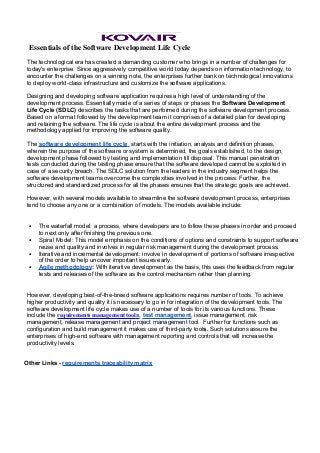Essentials of the Software Development Life Cycle
•
1 gostou•554 visualizações
The technological era has created a demanding customer who brings in a number of challenges for today's enterprise. Since aggressively competitive world today depends on information technology, to encounter the challenges on a winning note, the enterprises further bank on technological innovations to deploy world-class infrastructure and customize the software applications.
Denunciar
Compartilhar
Denunciar
Compartilhar
Baixar para ler offline

Recomendados
Estado de transitabilidad de las rutas nacionales afectadas por anegamientos

Estado de transitabilidad de las rutas nacionales afectadas por anegamientosSiemprefm Cientouno Punto Cinco
Recomendados
Estado de transitabilidad de las rutas nacionales afectadas por anegamientos

Estado de transitabilidad de las rutas nacionales afectadas por anegamientosSiemprefm Cientouno Punto Cinco
Mais conteúdo relacionado
Destaque (6)
Future 'research' hospital 2015: a patient perspective

Future 'research' hospital 2015: a patient perspective
Mais de Kovair
Mais de Kovair (20)
Global Chip Company Leverages Kovair Omnibus to Support End-to-End Product De...

Global Chip Company Leverages Kovair Omnibus to Support End-to-End Product De...
Data Migration from Jira Zephyr to Azure and Vice Versa

Data Migration from Jira Zephyr to Azure and Vice Versa
Migration of Two Million Records with Zero Downtime for a Global Financial Or...

Migration of Two Million Records with Zero Downtime for a Global Financial Or...
Ace Up Strategic Decisions Using Kovair PPM - Whitepaper

Ace Up Strategic Decisions Using Kovair PPM - Whitepaper
Introduction to Kovair QuickSync for Data Migration

Introduction to Kovair QuickSync for Data Migration
Value Stream Delivery Platform for ALM, DevOps DevSecOps and Cloud-based SaaS...

Value Stream Delivery Platform for ALM, DevOps DevSecOps and Cloud-based SaaS...
Migration of Two Million Records with Zero Downtime for a Global Financial Or...

Migration of Two Million Records with Zero Downtime for a Global Financial Or...
Kovair Capabilities for Automotive Development with Kovair ALM – White Paper

Kovair Capabilities for Automotive Development with Kovair ALM – White Paper
Kovair Automotive Solution’s Compliance for ISO 26262 & ASPICE - Whitepaper

Kovair Automotive Solution’s Compliance for ISO 26262 & ASPICE - Whitepaper
Essentials of the Software Development Life Cycle
- 1. Essentials of the Software Development Life Cycle The technological era has created a demanding customer who brings in a number of challenges for today's enterprise. Since aggressively competitive world today depends on information technology, to encounter the challenges on a winning note, the enterprises further bank on technological innovations to deploy world-class infrastructure and customize the software applications. Designing and developing software application requires a high level of understanding of the development process. Essentially made of a series of steps or phases the Software Development Life Cycle (SDLC) describes the tasks that are performed during the software development process. Based on a format followed by the development team it comprises of a detailed plan for developing and retaining the software. The life cycle is about the entire development process and the methodology applied for improving the software quality. The software development life cycle starts with the initiation, analysis and definition phases, wherein the purpose of the software or system is determined, the goals established, to the design, development phase followed by testing and implementation till disposal. This manual penetration tests conducted during the testing phase ensure that the software developed cannot be exploited in case of a security breach. The SDLC solution from the leaders in the industry segment helps the software development teams overcome the complexities involved in the process. Further, the structured and standardized process for all the phases ensures that the strategic goals are achieved. However, with several models available to streamline the software development process, enterprises tend to choose any one or a combination of models. The models available include: • The waterfall model: a process, where developers are to follow these phases in order and proceed to next only after finishing the previous one. • Spiral Model: This model emphasis on the conditions of options and constraints to support software reuse and quality and involves in regular risk management during the development process. • Iterative and incremental development: involve in development of portions of software irrespective of the order to help uncover important issues early. • Agile methodology: With iterative development as the basis, this uses the feedback from regular tests and releases of the software as the control mechanism rather than planning. However, developing best-of-the-breed software applications requires number of tools. To achieve higher productivity and quality it is necessary to go in for integration of the development tools. The software development life cycle makes use of a number of tools for its various functions. These include the requirements management tools, test management, issue management, risk management, release management and project management tool. Further for functions such as configuration and build management it makes use of third-party tools. Such solutions assure the enterprises of high-end software with management reporting and controls that will increase the productivity levels. Other Links - requirements traceability matrix
